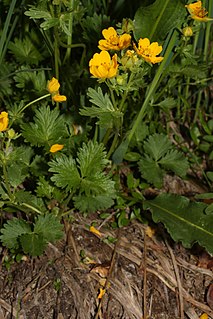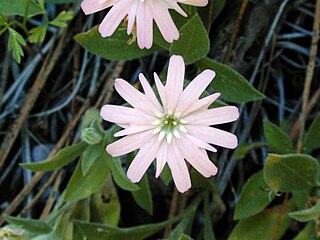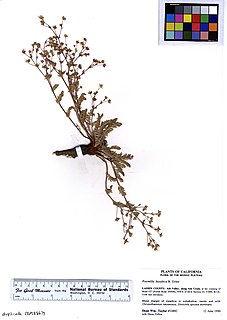
Dasiphora fruticosa is a species of hardy deciduous flowering shrub in the family Rosaceae, native to the cool temperate and subarctic regions of the northern hemisphere, often growing at high altitudes in mountains. Dasiphora fruticosa is a disputed name, and the plant is still widely referenced in the horticultural literature under its synonym Potentilla fruticosa. Common names include shrubby cinquefoil, golden hardhack, bush cinquefoil, shrubby five-finger, tundra rose, and widdy.

Platystemon is a monotypic genus of flowering plants in the poppy family containing the single species Platystemon californicus, which is known by the common name creamcups. It is native to Oregon, California, Arizona, Utah and Baja California, and is found in open grasslands and sandy soils below 6,000 feet (1,800 m) elevation.

Drymocallis arguta, commonly known as the tall cinquefoil, prairie cinquefoil, or sticky cinquefoil, is a perennial herbaceous plant native to North America. It was formerly included with the typical cinquefoils in the genus Potentilla.

Potentilla gracilis, known as slender cinquefoil or graceful cinquefoil, is a species of cinquefoil.

Horkelia californica, known by the common name California horkelia, is a species of flowering plant in the rose family.

Potentilla recta, the sulphur cinquefoil or rough-fruited cinquefoil, is a species of cinquefoil. It is native to Eurasia but it is present in North America as an introduced species, ranging through almost the entire continent except the northernmost part of Canada and Alaska.
Potentilla biennis is a species of cinquefoil known by the common names biennial cinquefoil and Greene's cinquefoil. It is native to western North America from northwestern Canada to the southwestern United States, where it grows in moist habitat. This is an annual or biennial herb producing an erect stem up to 70 centimeters tall from a taproot. It is hairy and glandular in texture. The hairy leaves are each divided into three toothed, oval leaflets each up to 3 centimeters long. The inflorescence is a cyme of several flowers. Each flower has five oval yellow petals 1 or 2 millimeters long and five triangular sepals which are slightly longer. The fruit is a minute whitish achene.

Potentilla diversifolia or Potentilla × diversifolia is a species of flowering plant in the Rose Family (Rosaceae) known by the common names varileaf cinquefoil, different-leaved cinquefoil, and mountain meadow cinquefoil.

Potentilla flabellifolia is a species of cinquefoil known by the common names high mountain cinquefoil, fanleaf cinquefoil and fan-foil.
Potentilla millefolia is a species of cinquefoil known by the common names cutleaf cinquefoil and feather cinquefoil. It is native to Oregon, Nevada and eastern California, where it grows in moist mountain meadows and similar habitat. The plant produces a basal rosette from a taproot, then a decumbent stem up to about 20 centimeters in maximum length. The elongated leaves are made up of several overlapping pairs of deeply lobed leaflets. The inflorescence at the tip of the stem is a cyme of a few flowers, each with usually five yellow petals under a centimeter long.

Potentilla norvegica is a species of cinquefoil known by the common names rough cinquefoil, ternate-leaved cinquefoil, and Norwegian cinquefoil. It is native to Europe, Asia, and parts of North America, and it can be found elsewhere as an introduced species.
Potentilla pseudosericea is a species of cinquefoil known by the common names silky cinquefoil and Mono cinquefoil. It is native to the Sierra Nevada of California and mountain ranges just to the east, where its distribution extends into Nevada. It grows in rocky mountainous habitat. It is a small plant forming mats or tufts in rock cracks and talus, its short stem growing from a caudex. The leaves are generally palmate, divided into five leaflets. The leaflets are deeply lobed along the edges and woolly in texture, coated in white or silvery hairs. The inflorescence is a cluster of a few yellow flowers with petals around 3 millimeters long each.
Potentilla wheeleri is a species of cinquefoil known by the common name Kern cinquefoil or Wheeler's cinquefoil. It is native to the Sierra Nevada and nearby ranges of California and it has been reported from Arizona and Baja California. Its habitat includes moist areas in mountainous regions. This tuftlike plant produces spreading, decumbent stems with leaves sometimes arranged in a rosette about the caudex. The hairy stems reach a maximum length near 25 centimeters. The rough-haired leaves are palmate, each divided into five wedge-shaped leaflets which are lined or tipped with teeth. The inflorescence is a cyme of several flowers with yellow petals each a few millimeters long.

Senna multiglandulosa is a species of flowering plant in the legume family known by several common names, including glandular senna, downy senna, and buttercup bush. It is native to Mexico, Guatemala, and western parts of South America, but it is widely cultivated as an ornamental plant and in some areas of the world has become naturalized in the wild. In some places it is considered a weed, for example, in New Zealand and New South Wales.

Silene hookeri is a species of flowering plant in the pink family known by the common names Hooker's silene, Hooker's catchfly, Hooker's Indian pink, and Hooker's glandular campion.

Spergularia macrotheca is a species of flowering plant in the pink family known by the common name sticky sandspurry. It is native to western North America from British Columbia to Baja California, where it grows in many types of moist coastal and inland habitat, often in alkaline and saline substrates. It may be found in marshes, alkali flats, beaches, meadows, seeps, and vernal pools. It is a perennial herb producing a narrow stem up to 40 centimeters long with a woody, thickened base and taproot. They may grow erect or prostrate across the ground. It is covered in sticky glandular hairs, especially in the inflorescence. The stems are lined with fleshy linear leaves, sometimes tipped with spines. The leaves are accompanied by triangular stipules up to a centimeter long each. Flowers occur in clusters at the end of the stem as well as in leaf axils. The small flowers have five pointed sepals and five oval white to lavender-pink petals. The fruit is a capsule containing tiny reddish brown, winged seeds.

Spergularia villosa is a species of flowering plant in the pink family known by the common name hairy sandspurry. It is native to southern South America, and it is known in the southwestern United States and Baja California as an introduced species and casual weed. It grows in a wide variety of habitat types. It is a small perennial herb producing a sprawling stem up to 30 centimeters long with a woody base. It is coated in glandular hairs. The leaves are generally linear in shape and measure a few centimeters long. They are accompanied by dull white lance-shaped stipules. The flowers have hairy, glandular sepals and five oval whitish petals.
Potentilla johnstonii is a rare species of flowering plant in the rose family known by the common name sagebrush cinquefoil. It is native to Nevada, where it has been collected from only one spot in the Quinn Canyon Range of Nye County.

Potentilla hippiana is a species of flowering plant in the rose family known by the common names woolly cinquefoil, horse cinquefoil, and Hipp's cinquefoil. It is native to North America, where it occurs in western Canada and the western United States. It occurs in eastern Canada and the US state of Michigan as an introduced species.

Potentilla basaltica is a species of flowering plant in the rose family known by the common names Soldier Meadows cinquefoil and basalt cinquefoil. It is endemic to a small area of the Modoc Plateau and Warner Mountains in northeastern California and northwestern Nevada.

























